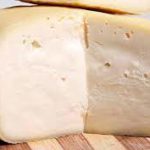Hundred Per Hundred Gallego cheese. It is a fresh cheese of white paste, soft and granular, made with cow’s milk.
Completely natural without preservatives or additives.

Hundred Per Hundred Gallego cheese
Cheese made from cow’s milk that, after a production process that includes the phases of:
coagulation
cut curd
disheveled
Kneaded and salted
molded
pressed
maturation and
in your case, cured
The cured cheese has a slightly differentiated crust and its paste, yellow in color that can reach intense yellow, has a hard consistency at times and always firmer than buttery.
Its flavor is somewhat metallic, spicy and dairy, with characteristic aroma.
As regards fresh cheese, it does not have a differentiated crust, the dough is white and granulated, soft, clayey to the touch, unctuous, melting on the palate.
Its taste and aroma are reminiscent of the milk from which they come, slightly acidic.
From my personal tasting, I prefer more for the latter, the first one, the curing is difficult to direct in the mouth, because it sticks a lot to the palate, and throat and to be able to swallow it is necessary to drink liquid.
I could only take it by adding honey, but still.
However, the fresh is very grateful to the palate and with honey or just delicious.
CEBREIRO.Hundred Per Hundred cheese
Production area covers thirteen municipalities in the eastern region of Lugo.
Milk used is that of the healthy cattle of the breeds Rubia Gallega, Pardo Alpina and Friesland, reared in the area.
The cheese is made with pasteurized whole milk and rennet of animal origin or other authorized.
The zone protected by the D.O.P. “Cebreiro” presents an oceanic mountain climate. It is characterized by the strong degradation of the maritime influence and by the accentuation of the continental characteristics.
This is an important limitation for agricultural activities.
A large part of the territory, above 1,000 meters of altitude, has a temperature regime that could be characterized as “very cold”, within what are the general conditions for Galicia, with a frost-free period of less than 5 months .
As a consequence of the unfavorable conditions of the environment, livestock activity is fundamental for the economy of the area because the climatic, soil and orographic conditions are less hostile to agriculture, due to the presence of good natural meadows and pastures (although on small areas), due to the possibility of using as pastures the numerous areas of mountains and the adaptation of livestock to the climatic rigors
ANCESTRAL CHEESES
The origin of these cheeses is attributed to the first monks who settled in the town of Cebreiro entry point in Galicia of the French Way.
Main route of pilgrimage to Santiago to attend the hospital that was built in the late ninth century to meet the needs of pilgrims.
Throughout the centuries, pilgrims tasted cheese in the mountains of Cebreiro and made it known throughout Spain and Europe.
The documentation kept in the National Historical Archive and in the General Archive of Simancas, allows us to sketch curious notes related to the dispatch, on an annual basis, of cheese made in Cebreiro for consumption by the Portuguese Royal House during the reign of Carlos III.
Cheese was made in their homes by the villagers of the region (mainly women) from November.
The consignments always consisted of two dozen cheeses.
It was carried out in the last fortnight of the year, taking advantage of seasonal coldness for its best conservation.
To be delivered in the first half of January as a treat to the Queen of Portugal.
Other aspects. Hundred Per Hundred cheese

In addition, various documents of the eighteenth and nineteenth centuries also credit the notoriety that had Cebreiro cheese at that time.
Going now to more recent bibliographical references, in the book “General Geography of the Kingdom of Galicia (1936)”, information is collected regarding the cheese of Cebreiro, its characteristics and way of elaboration.
Later, and already in the sixties of the last century, Carlos Compairé Fernández, scholar of Spanish cheeses in general and Galician in particular, published several works in which an extensive study of these cheeses is made, including chemical and bacteriological analysis.
We could say that they are the first scientific studies on them.
In the “Spanish Inventory of Traditional Products”, published by the Ministry of Agriculture, Fisheries and Food in 1996, it includes, in the chapter dedicated to cheeses, a wide range of information about Cebreiro cheese, with information about its characteristics, its way of elaboration, its history and its economic importance.
The pilgrims who enter Galicia on their way to Compostela through the town of O Cebreiro appreciate the uniqueness of the “pallozas”.
Houses with thatched roof of pre-Roman origin, the hospitality of its people, the legend that places the Holy Grail in the sanctuary of the town and, without a doubt, the taste and presentation of the cheeses made here.
Currently, the production area of the Protected Designation of Origin Cebreiro includes the municipalities of:
Pedrafita,
O Caurel,
Cervantes,
Triacastela,
As Nogais,
Navia de Suarna,
Becerreá
Baralla,
Baleira,
Castroverde,
A Fonsagrada,
Láncara e Samos.
The “Queixo do Cebreiro”, ideal to take alone, with honey or with fruit candy.
It is also an ingredient of enormous possibilities for dishes of all kinds.
By ANGEL MARQUES DE AVILA. Journalist.